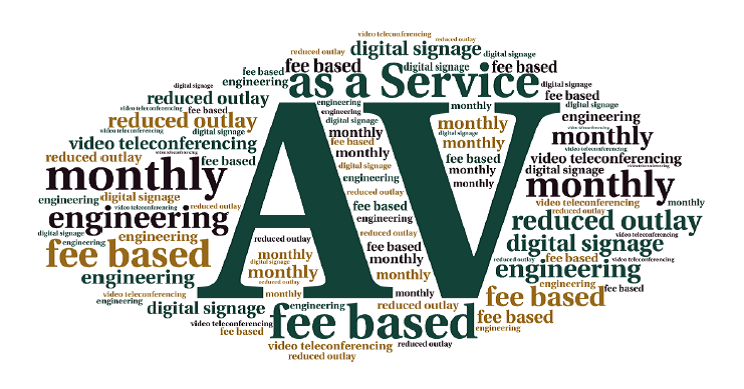AV as a Service?
If you have gone to any AV leadership event over the last several years, ranging from the Commercial Integrator Summit to InfoComm’s AVEC to NSCA’s Business and Leadership Conference, you know that developing a revenue stream based on service has been at the forefront of the conversation.
Many integrators have started offering managed services to their clients, not only as a way to create value, but also to offset falling average selling prices and reduced margins. They are making investments in help desk software, remote analytics, and CRM systems to deliver the professional support services that their cilents require to proactively manage their equipment and reduce downtime.
Some manufacturers have also entered into the services arena through service contracts. Some of these service agreements have been received better than others depending on the actual value received by the integrator and the end user. In some cases, the service agreements are not optional, and are required as ongoing fees to keep the equipment operational.
Other manufacturers have experimented with the idea of licensing fees as a way to generate additional revenue. In my experiences, integrators and end users alike have not taken well to that scenario. I have seen security network video recording manufacturers and home automation companies both try this approach. The latest experiment with this revenue model I saw was by a control manufacturer who stopped making video switching equipment due to falling margins. Instead, they decided to just create control code for third party video switchers and then charge a licensing fee for every video port used in the system. An end user who wanted to add a new source or an additional display would then have to buy a license for those ports to enable their control. (Insert groan here).
Today, we are also starting to see AV companies and manufacturers adopt the “as a Service” model from the IT world. So what does AV as a Service, AVaaS, actually mean?

If you are unfamiliar with the concept, “as a Service” models typically reduce or eliminate the upfront cost of buying hardware or software for their full price, instead offering an ongoing subscription through monthly payments. Software as a Service, SaaS, models can be of great value to IT organizations, especially in managing versions of software and compatibility.
Take Office 365 or Adobe Creative Cloud as examples. Companies embracing these platforms pay a fee for the software per user each month. The software is automatically updated to newer versions as they become available, meaning the days of having to save Word docs as older versions when sending to specific employees are over. The overall cost of the monthly fees will add up to more than the direct purchase of the software, but the savings in IT support and updating and managing several versions of the software overtime fade to $0.
Given this, AVaaS can be tricky. The upfront hardware costs of flat panels, touch panels and control systems would have to be absorbed on the front end by either the integrator or the manufacturer and then recouped overtime through monthly payments. For that reason, I don’t think we will see a complete AVaaS offering for some time. However, there are a few companies in the AV space successfully offering AVaaS in very specialized market segments that are worth taking a look at.
Video Teleconferencing as a Service
The world of unified communications has seen a large amount of growth in the last decade, especially when it comes to Video Teleconferencing, VTC. The first iteration of VTC involved proprietary codecs at each location that facilitated secure calls through a network of infrastructure owned by the companies themselves. This arrangement gives companies the most control over the security of the devices as well as the quality of service, as they control all the hardware involved.
Due to the cost of these types of systems, software codec based systems like Skype, Lync, Zoom, Blue Jeans, etc. gained a lot of momentum over the last few years. These platforms use encryption as well to secure calls, but all of the infrastructure is off premise and companies access them for free or a small fee for the software depending on the types of meetings they need to run.
VTC as a Service is a model that lies in between these two. For companies that want the additional security and quality of a hard codec based system, but don’t want to incur a huge outlay for the equipment, companies like Arkadin may provide the answer.
Arkadin offers VTC as a Service through a company called Vidyo. Arkadin purchases the Vidyo hardware and client licenses required for each person who wants to join a call. They house the Vidyo servers in their own facility, creating a private cloud that companies can then purchase tiered access to on a monthly basis based on the number of calls and number of participants on each call. It allows companies to purchase access to VTC based on consumption needs and mitigate costly hardware for each location, given that some locations may see higher ROI on those investments than others.
Engineering as a Service
Many companies enlist the services of AV consultants in order to properly address their communications needs and assure that they are taking advantage of cutting edge technology design. Consultants are typically hired on a per project basis and the fees are commensurate with the amount of work those projects take. Because these fees are typically substantial, many times the IT departments may be forced to bid each project separately and if a different consultant wins the next project, the continuity of the designs across the projects can potentially suffer.
Enter AV Helpdesk.
AV Helpdesk offers an Engineering as a Service model that allows companies to hire them for a recurring monthly fee. AV Helpdesk then becomes a trusted part of the IT staff, designing and engineering not only the large AV projects that happen periodically, but also adding value by being available to engineer smaller projects and AV upgrades that typically may not enlist a consultant. AV Helpdesk’s constant presence allows them to partner with their clients to create long term technology plans and to assure each project along the way, whether large or small, utilizes a design and technology that adhere to that road map. This model allows companies to eliminate large spikes in spending on AV design services and replace the project based fees with a fixed monthly amount, as well as mitigate potential compatibility issues with systems designed by different firms with different intentions.
Digital Signage as a Service
One of the most recent entrants into the “as a service’ arena is Convergent, which is now offering Digital Signage as a Service (DSaaS).
The Convergent offering provides Digital Signage content creation, content management, content deployment with continued content updates along with 24/7 monitoring and next day replace or repair service, all for a small recurring monthly fee. The service includes professionally created “Spot Packs,” (with full screen graphics and custom messaging) and a SpinetiX digital signage Hyper Media Player. Based on their preliminary pricing, a corporate facility could have several displays running current and relevant managed content with the capability to add and grow as needed, all for a very affordable monthly charge.
This offering does require the client to provide their own displays with cabling, but the SpinetiX networked Hyper Media Players and the content management are included with the monthly service, which means Convergent may have solved the most challenging part of the digital signage puzzle.
The three scenarios above illustrate that AVaaS can be a great way to offer value to integrators and end users alike without having to have pockets deep enough to seed millions of dollars of hardware into the market. The trick is to actually offer reduced up front costs while minimizing hardware investments and then add value that substantiates the monthly fees. The three companies above have shown that it is possible do all these things.
Some other companies will surely use the AVaaS acronym without delivering the value and reduced initial costs that come with the model, and in that case, they will really just be making an “aaS” out of themselves.

What are some other opportunities for AVaaS models to take hold? I have a few ideas and I’d also love to hear yours in the comments below.





